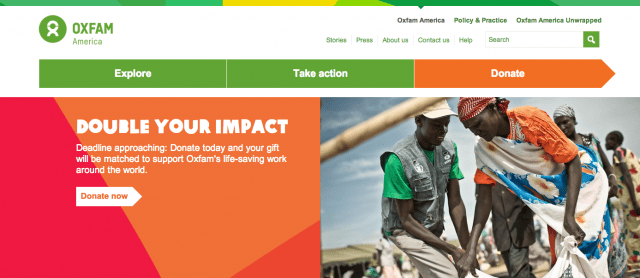Speaking the Language of Nonprofit Donation Appeals

Nonprofits can’t indefinitely rely on the same fundraising appeal any more than for-profit businesses can use the same advertisement over and over again. In either case, the language and imagery of the marketing becomes predictable, boring, even invisible. Nonprofit professionals are constantly working on new appeals and marketing campaigns to catch the public’s attention. Development departments must be diligent, clever, and inventive to convince donors to take action.
Fortunately, we can draw on research into language, persuasion, and marketing to help create effective appeals and communications. In this blog post, we will comb through this research and some reliable storytelling and marketing archetypes to produce the message.
After that, we will check out some hard-working words that have proved themselves to be effective tools for persuasion. Finally, we’ll go over some basic linguistic guidelines to help polish your appeals.
Approaching the Appeal
Choosing your approach to an appeal is as important as a pilot choosing his approach to the landing strip. Even if the pilot does everything else right, an incorrect approach could have a disastrous landing. Crafting your appeal begins with choosing the approach – the reason donors must act. This reason could be a natural disaster, donation matching period, or even a tax break. Most people want to do good, but you need to give them a specific reason they should do good now.
Here are a few structures marketers and fundraisers can build on to create a compelling appeal.
The “Act Now!” Approach

This approach is all about creating a sense of urgency, with an impending consequence of not taking action. Often this will be based on FOMO (fear of missing out). In a for-profit business, marketers create this fear of missing out by emphasizing that their product is on sale for a limited time. The consumer feels pressure to buy the product now because if they decide to buy in the future, it may cost them more.
We can adapt the “Act Now!” approach to fundraising in a number of ways. Campaigns that urge a donor to give today because someone is matching donations gives a reason for the donor to act now rather than later. If they give $25 now, their gift will actually result in $50 given to the cause.
Although this option is less concrete, you can also urge your audience to Act Now by linking time to the continued existence of a chronic problem. For example: “Give now, before more children go to bed hungry!” This reminds donors that the people in need of their help may already be suffering. This approach to fundraising appeals can make a distant or ongoing cause more pressing and impactful.
The Identity Approach
The Identity Approach makes the appeal about the audience. This is a favorite of corporate advertisers who want to link a product to consumers’ sense of self. By showing a group of laughing people having fun with a certain beverage in their hand, companies try to link fun, popularity, and happiness with their product. Who knows? It might even make you better looking. (It won’t.)
The nonprofit fundraising applications of the Identity approach aren’t as dastardly as the many for-profit examples. One of the best-known examples of engaging a donor’s identity happens all the time on public radio stations. Many public stations end their programs by reminding the audience that their content is supported by “listeners like you.”
In this case, the audience is forced to consider their role in the station’s very existence. And, more importantly, the statement “listeners like you,” draws a direct connection between the audience and the impact of their donations.
Get Now: The Donor Retention Handbook
The Identity approach is also used frequently in appeals for monthly giving. A nonprofit may give a special title or benefit to recurring donors. Whether they keep it to themselves or shout it from the rooftops, you can bet monthly donors to the American Red Cross feel good when their emails are addressed to the organization’s “Champions.” You can use the identity approach to remind donors how good it feels to be charitable and to create a loyal community out of recurring supporters.
The Unexpected Approach
Surprises can prompt us to hunt for underlying causes…to imagine other possibilities.
Part of the reason you can’t use the same appeal over and over again is that once people know what to expect, they stop paying attention. It can show up in tuning out ads you’ve heard a dozen times on the radio or missing out on new information in a lecture because you think you already know the topic well.
A surefire way to get people to pay attention is to make them feel surprised or confused. As the Heath brothers say in their bestselling marketing book Made to Stick, “unexpected ideas are more likely to stick because surprise makes us pay attention and think … Surprise can prompt us to hunt for underlying causes, to imagine other possibilities, to figure out how to avoid surprises in the future.”
You can surprise your audience by portraying your cause in an unexpected context, by revealing an unexpected consequence, or even by offering an unexpected solution. In any of these cases, the goal is to show donors who thought they knew enough about the cause something they hadn’t considered.
In only a week, more than 4 million people were driven to find out.
Greenpeace wanted to publicize Lego’s partnership with the Shell Oil Company, and the environmental damage the company does. The video drew a ton of attention to the relationship and was even covered by Time Magazine and AdWeek.
Read Next: 5 Compelling Nonprofit Videos That Spark Action
This is just one example of the power of surprise. Think about how you can grab your audience’s attention by making them wonder “what’s this about?” The Heath brothers explained it well, writing, “surprise makes us want to find an answer – to resolve the question of why we were surprised.” And to find the answer, your audience must engage further.
Hard-Working Words
The words you choose matter. Researchers have found that some words are more persuasive than others, so if you have a choice you should use them. There are some great lists of marketing words and conversion words online. We’ve chosen just a few to show how they can be applied (but you can find a ton more on the Buffer blog) and that post also features an infographic showing the best words for each social networking platform.
- You – using “you” or the audience’s name in your appeal makes it seem more personal (remember “listeners like you”?)
- Instantly – promising something instantly is just more than most people can pass up
- Because – this word signals that you have a good reason for asking (it works especially well with the “Act Now!” approach)
- Join – using the word “join” turns a solicitation into an invitation – you don’t just want their money, you want them!
- Free – this implies that the audience is getting a special deal, that they are coming out ahead (you can tie a free newsletter or bumper sticker to monthly donations)
A Few Guidelines for Awesome Appeals
Finally, here are a few tips for to clean up your appeal and make sure it’s ready to go out and work for you.
- Keep it Short – Get to the point in your appeal. What do you need and why? You can always make more info available.
- Lose the Jargon – Don’t use industry-specific terms unless you only want donations from industry insiders. If you want all the donations you can get, write simply.
- Show the Next Step – Make sure the link to your donation page is visible. Donors should be able to take action with the click of a button.
Image Credit: Marc Wathieu

A Guide to Peer-to-Peer Fundraising Emails



